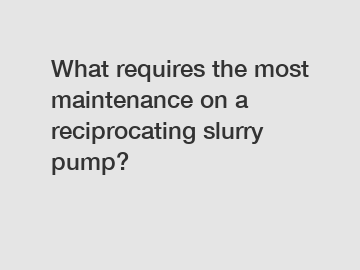What requires the most maintenance on a reciprocating slurry pump?
What requires the most maintenance on a reciprocating slurry pump?
Reciprocating slurry pumps play a crucial role in various industries, from mining and construction to oil and gas. These pumps are designed to handle abrasive and corrosive fluids, making them ideal for transferring slurries. Like any other mechanical equipment, reciprocating slurry pumps require regular maintenance to ensure optimal performance and extend their lifespan. However, certain components demand more attention than others. In this article, we will explore the key areas that require the most maintenance on a reciprocating slurry pump.
1. Seals and Packing:

The seals and packing of a reciprocating slurry pump serve as critical barriers between the pump's internal parts and the slurry being pumped. Due to the abrasive nature of most slurries, these components often experience significant wear and tear. Regular inspection and replacement of seals and packing are essential to prevent leaks and pump failure. Ensure that the seals are lubricated properly and replace them as soon as signs of deterioration are noticed.
2. Valves and Seats:
Reciprocating slurry pumps feature valves and seats that control the flow of the slurry. However, constant exposure to abrasive particles can cause the valves and seats to wear out quickly. It is crucial to regularly inspect and clean these components to prevent clogging and ensure proper flow. Any signs of erosion should prompt immediate replacement to avoid pump inefficiency and downtime.
3. Pistons and Rods:
Pistons and rods play a vital role in the reciprocating action of the pump. The continuous back-and-forth movement of these components exposes them to high stress and wear. Regular lubrication, inspection, and cleaning are necessary to ensure smooth operation. Any signs of cracks or excessive wear should not be ignored, as they can lead to catastrophic failure.
4. Liners:
Slurry pumps rely on liners made of robust materials like rubber or metal to protect the casing from erosion. However, even the most durable liners eventually wear out, especially when dealing with highly abrasive slurries. Routine inspection and replacement of liners are essential to maintain pump efficiency. Ignoring worn liners can not only result in decreased performance but also lead to expensive repairs or replacement of the rest of the pump components.
5. Drive System:
The drive system of a reciprocating slurry pump includes various components such as belts, pulleys, and gears that transmit power from the motor to the pump. These components are subject to wear and should be inspected regularly. Proper tensioning of belts, lubrication of gears, and alignment of pulleys are necessary to prevent premature failure. Additionally, checking for any abnormal noise or vibrations from the drive system can help detect issues early on.
In conclusion, maintaining a reciprocating slurry pump requires diligent attention to certain key areas. Seals and packing, valves and seats, pistons and rods, liners, and the drive system are components that demand the most maintenance. Regular inspection, cleaning, lubrication, and timely replacement of worn or damaged parts are essential to ensuring the pump's optimal performance, avoiding costly breakdowns, and extending its lifespan. By prioritizing maintenance efforts on these components, industries can minimize downtime, reduce repair costs, and maximize the efficiency of their reciprocating slurry pumps.
The company is the world’s best Rubber Lined Pumps, Rubber Slurry Pump for Sale, Warman Pump Spares supplier. We are your one-stop shop for all needs. Our staff are highly-specialized and will help you find the product you need.

Comments